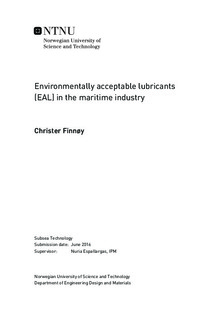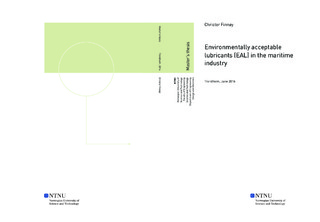| dc.description.abstract | All dynamic mechanical equipment needs lubrication to perform in a best possible way. In
the maritime industry, e.g. ships, many of the most important dynamic mechanical systems
are located beneath the surface of the sea. Examples of equipment are thrusters, stern tubes
and ship stabilizers. All these components are dependent on proper lubrication to perform
optimally and secure a long service-life. In the interface between the seawater moving parts, a
seal is required to separate the oil and seawater from each other. Due to new requirements,
conventional mineral oil shall be exchanged with an environmentally acceptable lubricant
(EAL).
In this study dierent elastomers were tested against dierent steels (S355-steel and NiCrsteel)
with two dierent oils (Shell Omala 68 and Kl uberbio EG 2-68). The motivation
for performing the tests was to identify the tribological properties of the elastomers in the
required EAL compared to the oil in use, and occurring mechanisms and the chemomechanical
eects of the lubricants in interaction with the seal. The testing was performed at lab
scale using a "Pin-on-plate" conguration in a tribomachine. To investigate the eect of
the lubricants on the elastomers two soaking tests were performed, and soaked samples were
tribologically evaluated.
The result from this study showed that the conventional mineral oil give the lowest coecient
of friction (COF) when comparing the two oils. When comparing the elastomers, NBR
showed a lower COF than FKM. It was concluded that all the elastomers are operating in
a boundary/mixed lubrication regime. NBR exhibit higher wear compared to FKM in most
situations, exceptions are when adding abrasive particles (Silicon Carbides) to the lubricant
and the contact pressure (CP) is low. Transfer of polymer from adhesive wear towards the
metal surface could be observed for all elastomers. The results from the soaking tests showed
that EAL degrade NBR more than conventional oil and that higher temperatures accelerate
the degradation. In the soaking test FKM gained mass from aging. This study gives pointers
of expected behaviour in the sealing system. | |

